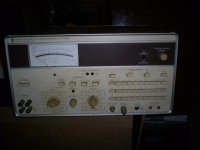Overview?
Hi,
Would you mind giving a brief overview of the capabilities of the equipment. I did a google search and found a number for sale, but nothing telling me about the limits of the equipment etc.
Does it need/has it had calibration or any other ongoing TLC?
Also is this a piece of solid state equipment?
Thanks
Stuart
Hi,
Would you mind giving a brief overview of the capabilities of the equipment. I did a google search and found a number for sale, but nothing telling me about the limits of the equipment etc.
Does it need/has it had calibration or any other ongoing TLC?
Also is this a piece of solid state equipment?
Thanks
Stuart
Stuart,
I have been using this piece of equipment for the last year when needed. I bought it off of a High end audio technician, but I do not know when it was last calibrated.
I looked this up on the net as to uses, It can to THM with a load bank. I used it to match components, and amplifier sides. when you are looking at distortion/gain per side it makes matching pretty easy. Because of space issues I have to get rid of this one and replace with more of a home made solution.
Here is a text book example of its uses. There is an oscillator built into the unit to facilitate these tests.
"Distortion analysis is a type of transient analysis that applies a single frequency sinusoidal signal to the named input source and measures the resulting distortion in the specified output expression using the IHD (Individual Harmonic Distortion) function.
If a pure single frequency sinusoidal signal at a specified fundamental frequency is applied to the circuit input and if the circuit is perfectly linear, the output will contain signal level only at the fundamental frequency of the input. The spectral content of the input and output will be the same except perhaps for a scale factor. There will be no distortion. To the extent that the circuit isn't perfectly linear, some output signal level will be found at frequencies other than the input frequency. In other words, some distortion will occur. The IHD function shows the distortion at each harmonic frequency as a percent of the signal level at the fundamental frequency. "
I have been using this piece of equipment for the last year when needed. I bought it off of a High end audio technician, but I do not know when it was last calibrated.
I looked this up on the net as to uses, It can to THM with a load bank. I used it to match components, and amplifier sides. when you are looking at distortion/gain per side it makes matching pretty easy. Because of space issues I have to get rid of this one and replace with more of a home made solution.
Here is a text book example of its uses. There is an oscillator built into the unit to facilitate these tests.
"Distortion analysis is a type of transient analysis that applies a single frequency sinusoidal signal to the named input source and measures the resulting distortion in the specified output expression using the IHD (Individual Harmonic Distortion) function.
If a pure single frequency sinusoidal signal at a specified fundamental frequency is applied to the circuit input and if the circuit is perfectly linear, the output will contain signal level only at the fundamental frequency of the input. The spectral content of the input and output will be the same except perhaps for a scale factor. There will be no distortion. To the extent that the circuit isn't perfectly linear, some output signal level will be found at frequencies other than the input frequency. In other words, some distortion will occur. The IHD function shows the distortion at each harmonic frequency as a percent of the signal level at the fundamental frequency. "
Specs?
Jeff,
Thanks for that, in addition I was wondering what level of THD the device can measure, what range of tests it can perform, ie THD, IMD, twin tone IMD etc, what center frequencies can be used etc.
Basically I wanted to get an idea of the accuracy and range the machine can be used for.
Thanks
Stuart
Jeff,
Thanks for that, in addition I was wondering what level of THD the device can measure, what range of tests it can perform, ie THD, IMD, twin tone IMD etc, what center frequencies can be used etc.
Basically I wanted to get an idea of the accuracy and range the machine can be used for.
Thanks
Stuart
- Status
- This old topic is closed. If you want to reopen this topic, contact a moderator using the "Report Post" button.

